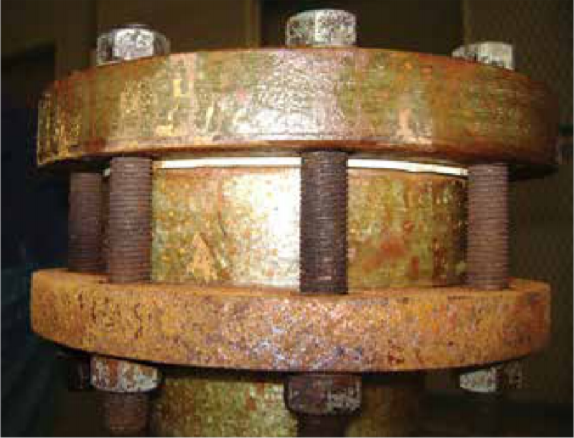Fiber Reinforced Plastic (FRP) pipes and flanges are increasingly used in the oil and gas industry where metal is simply too heavy and expensive. In addition to cost pressure, the need for lightweight chemically resistant materials are also driving the use of fiberglass pipes and flanges. Innovations in FRP flange design coupled with improvements in manufacturing technology have allowed FRP piping to be used in even more demanding applications. However, these demanding applications have added challenges for sealing the bolted flange connections.
More aggressive media and higher internal pressures have pushed the limits of the commonly used rubber gasketing materials, such as Nitrile Butadiene Rubber (NBR), Ethylene Propylene Diene Monomer (EPDM), or neoprene. Obtaining a reliable seal in FRP flanges using conventional gasketing materials has become more difficult.
Fiberglass pipes are generally known to have strength limits and a lower pressure resistance, making sealing fiberglass flanges difficult. Gore solved this problem with its patented expanded polytetrafluoroethylene (ePTFE) gasket, specifically designed to seal flanges at low stresses. This solution was successfully demonstrated in a multistage testing procedure conducted in cooperation with a globally leading manufacturer of anti-corrosive fiberglass pipe systems.
Testing the chemical and pressure resistance of FRP flange design
Based on the demand of a leading oil and gas company to provide technical solutions to innovative enhanced oil recovery (EOR) methods, the manufacturer of fiberglass pipe systems performed tests to demonstrate the performance of their piping technology at its facilities. Gore partnered with this manufacturer as ePTFE gaskets were selected to seal the flange connections and conducted a long-term exposure test.
The test objective was to prove the pressure stability, the residual seating stress, and the chemical compatibility of the FRP flange connection transporting 37 per cent hydrochloric acid (HCI). The test rig included FRP piping and flanges sealed using GORE Universal Pipe Gaskets (Style 800).The testing was conducted over 1000 hours.

The test system was filled with 37 per cent HCI and held for extended periods of time. After each defined exposure time, the test specimen was inspected for chemical attack. After 1000 hours of exposure, both the pipe and gasket were found to have no chemical attack. As a result, both the pipe and gasket were declared fit for use. After 1000 hours, 2208 hours and 4416 hours of chemical exposure to 37 per cent HCI, the test rig of DN100 size FRP piping and gasket was pressure tested for tightness. 22.5 bar pressure was held for 24 hours and no visual leakage was detected and no pressure drop occurred.
To confirm pressure resistance and compatibility with the specified seating stress in larger size pipes, a pressure tightness test was conducted in a DN400 size flange using the same pipe gasket under the following conditions: Flange: DN400, inner diameter (ID) 400 mm, outer diameter (OD) 509 mm stub end FRP flange, Design pressure: 15 bar, Testing pressure: 22.5 bar, Temperature: 65° C, Gasket: GORE Universal Pipe Gaskets (Style 800) DN400 PN16, ID 407 mm, OD 495 mm, Bolts: 16 Nos of 1" ASTM B7, Torque value: 330 Nm, Resulting gasket stress at installation 19 MPa, Holding time of applied pressure: 168 hours (seven days).
After seven days (168 hours) of holding the pressure at 22.5 bar, another hydrotest test was performed. The flange was retorqued to 560 Nm (31 MPa gasket stress) and pressure was raised to 60 bars (four times design pressure) and no leakage nor pressure loss was observed. Further increase of pressure resulted in leakage starting at 91 bar with no trace of pipe disintegration.
GORE ePTFE can meet the challenges of FRP piping systems
FRP piping connections have considerably advanced in the recent past. A design pressure of 15 bar is technically confirmed and tested for nominal sizes of up to 400 mm. High strength GORE Universal Pipe Gaskets are the gasket of choice for these applications when: (i) sufficient gasket stress can be applied and (ii) proper stress calculations are made to ensure integrity of the FRP flange system, the seal and the flange set-up. A flange set-up includes the stub-end ring, the bolts, the flanges and the gasket. To ensure successful performance, proper installation practice by using torque wrenches and lubricants during bolt tightening is necessary.
The conducted chemical and high pressure tests prove that GORE Universal Pipe Gaskets (Style 800) are well suited for FRP piping in aggressive media applications.
The original article was featured in Pipeline magazine and was written by Holger Stolpmann and Biju Philip at W.L. Gore & Associates. It can be found here.
Gallagher Fluid Seals is an authorized distributor of Gore products; joint sealants, gasket tapes, UPG gaskets, and other forms of ePTFE products. Contact us today to obtain a quote or to learn more about Gore's ePTFE products.
